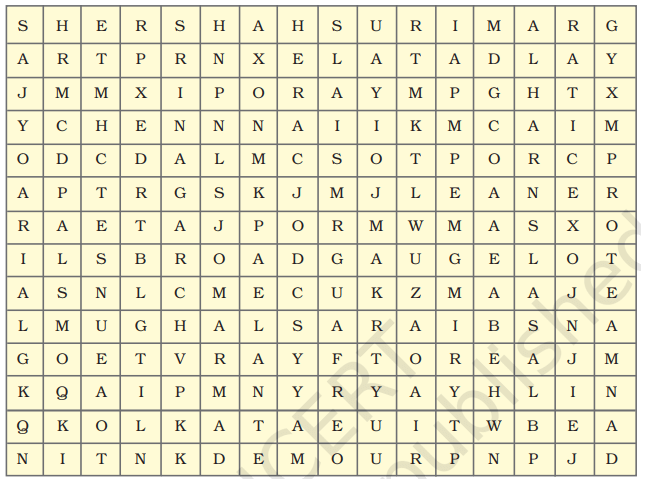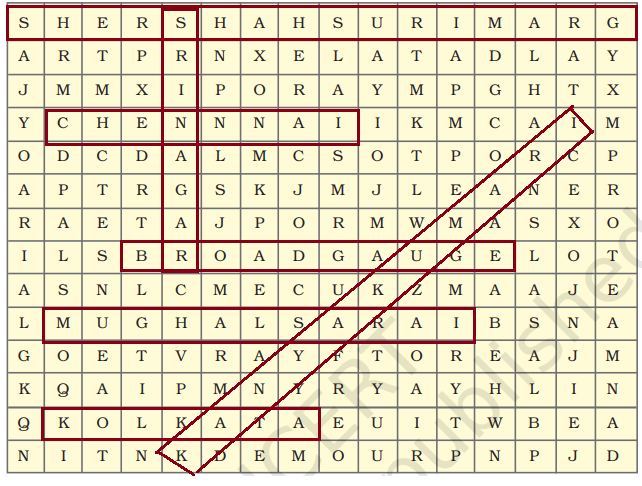Geography - Class 10
Contemporary India-II
Chapter 7: Lifelines of National Economy
Question 1: Multiple choice questions.
(i) Which two of the following extreme locations are connected by the eastwest corridor?
(a) Mumbai and Nagpur
(b) Silchar and Porbandar
(c) Mumbai and Kolkata
(d) Nagpur and Siligudi
(ii) Which mode of transportation reduces trans-shipment losses and delays?
(a) Railways
(b) Roadways
(c) Pipeline
(d) Waterways
(iii) Which one of the following states is not connected with the H.V.J. pipeline?
(a) Madhya Pradesh
(b) Maharashtra
(c) Gujarat
(d) Uttar Pradesh
(iv) Which one of the following ports is the deepest land-locked and well protected port along the east coast?
(a) Chennai
(b) Paradwip
(c) Tuticorin
(d) Vishakhapatnam
(v) Which one of the following is the most important modes of transportation in India?
(a) Pipeline
(b) Railways
(c) Roadways
(d) Airways
(vi) Which one of the following terms is used to describe trade between two or more countries?
(a) Internal trade
(b) International trade
(c) External trade
(d) Local trade
(i) (b) Silchar and Porbandar
(ii) (c) Pipeline
(iii) (b) Maharashtra
(iv) d) Vishakhapatnam
(v) (b) Railways
(vi) (b) International trade
Question 2: Answer the following questions in about 30 words.
(i) State any three merits of roadways.
Answer : Three merits of roadways are:
- Construction cost of roads is much lower than that of railway lines.
- Road transport is economical in transportation of few persons and relatively smaller amount of goods over short distances.
- Roads can traverse comparatively more dissected and undulating topography.
(ii) Where and why is rail transport the most convenient means of transportation?
Answer : Rail transport is the most convenient means of transportation in the northern plains as there is level land, high population density and rich agricultural resources.
(iii) What is the significance of the border roads?
Answer : Border roads are of strategic importance and these roads in the bordering areas of the country have improved accessibility in areas of difficult terrain and have helped in the economic development of these areas.
(iv) What is meant by trade? What is the difference between international and local trade?
Answer : The exchange of goods among people, states and countries is referred to as trade. Trade between two countries is called international trade. Trade carried out in cities, towns and villages are called local trades.
Question 3: Answer the following questions in about 120 words.
(i) Why are the means of transportation and communication called the lifelines of a nation and its economy?
Answer : The means of transportation and communication are called the lifelines of a nation and its economy because they are the pre-requisites for fast development. Today, India is well-linked with the rest of the world despite its vast size, diversity and linguistic and socio-cultural plurality. Railways, airways, waterways, newspapers, radio, cinema, television and internet etc. have been contributing to its socio-economic progress in many ways.
Along with trade, these different means of transport and communication have enriched our life and added substantially to growing amenities and facilities for the comforts of life.
(ii) Write a note on the changing nature of the international trade in the last fifteen years.
Answer : Trade between two countries is known as international trade. It has undergone a vast change in the last fifteen years. Exchange of goods and commodities have been superseded by the exchange of information and knowledge. For e.g. - India has emerged as a software giant at the international level and it is earning large foreign exchange through the export of information technology.
International trade also depends on the relationship between the countries and other external factors like duties and tariffs on the transportation of goods. In the last fifteen years, different trade blocks have emerged which have changed how international trade was conducted previously.
QUIZ DRIVE
Question :
- Northern terminal of the North-south corridor.
- The name of National Highway No.2.
- The headquarter of the southern railway zone.
- The rail gauge with a track width of 1.676 m.
- The southern terminal of the National Highway No.7.
- A Riverine Port.
- Busiest railway junction in Northern India.
- Srinagar
- Sher Shah Suri Marg
- Chennai
- Broad Gauge
- Kanyakumari
- Kolkata
- Mughal Sarai.
Activity
Start your search vertically, horizontally or diagonally and reach various destinations across the country


Intext Questions:
Question : Find out the places linked by national highways 2 and 3.
Answer : National Highway two runs from Delhi to Kolkata.
National Highway three runs from Agra to Mumbai.
Question : Find out the current railway zones and their headquarters.
Answer : There are total of 17 railway zones in India.
Northern railway zone in Delhi
Eastern railway zone in Kolkata
Southern railway zone in Chennai
Question : Why is air travel preferred in the north-eastern states?
Answer : The north-eastern part of the country is marked with the presence of big rivers, dissected relief, dense forests and frequent floods and international frontiers, etc. Air travel has made access easier to such places. It can cover very difficult terrains like high mountains, dreary deserts, dense forests and also long oceanic stretches with great ease.
Question : How we can help our railway in running as per the scheduled time?
Answer :- By not pulling the chain unnecessarily.
- By being punctual.
- By not damaging the railways properties.
Question : Find out the names of the countries connected by Indian Airlines.
Answer :The countries connected by Indian airlines are:
- Nepal
- Bhutan
- Pakistan
- Bangladesh
- Thailand
- Malaysia
- Singapore
- Sri Lanka
- Kuwait
- Qatar
- UAE